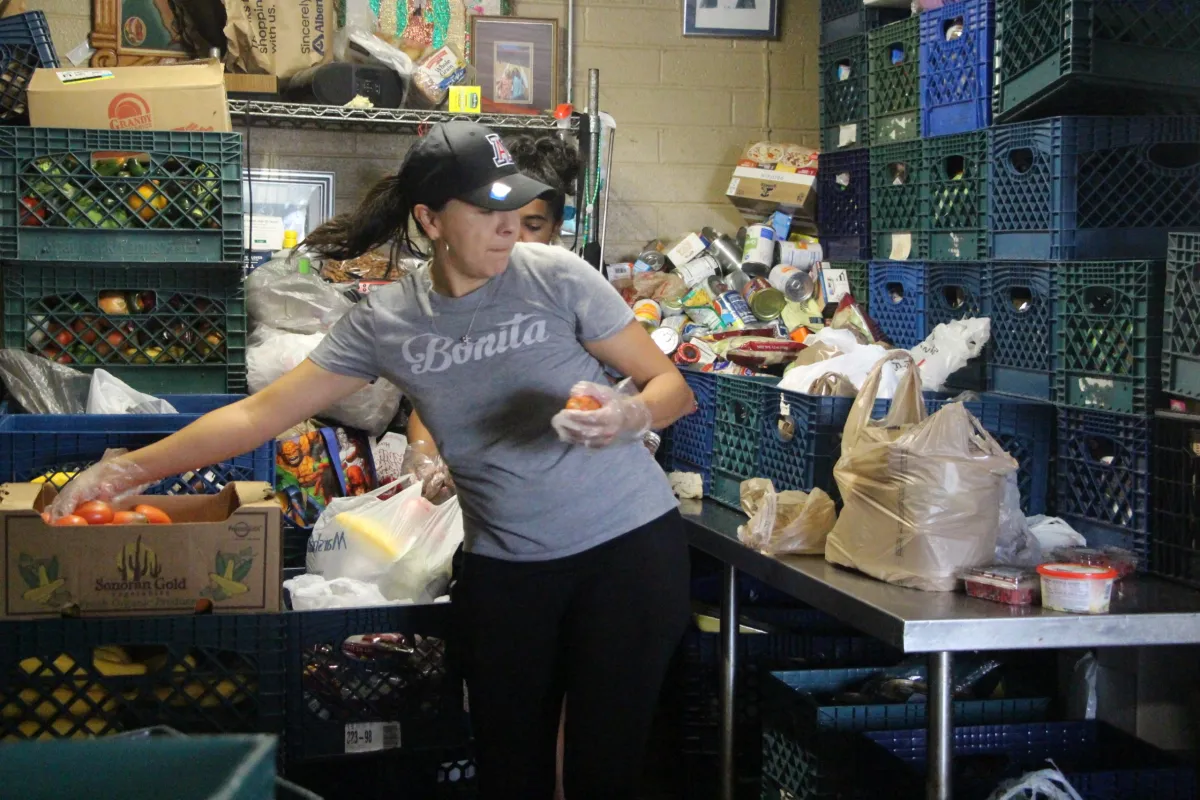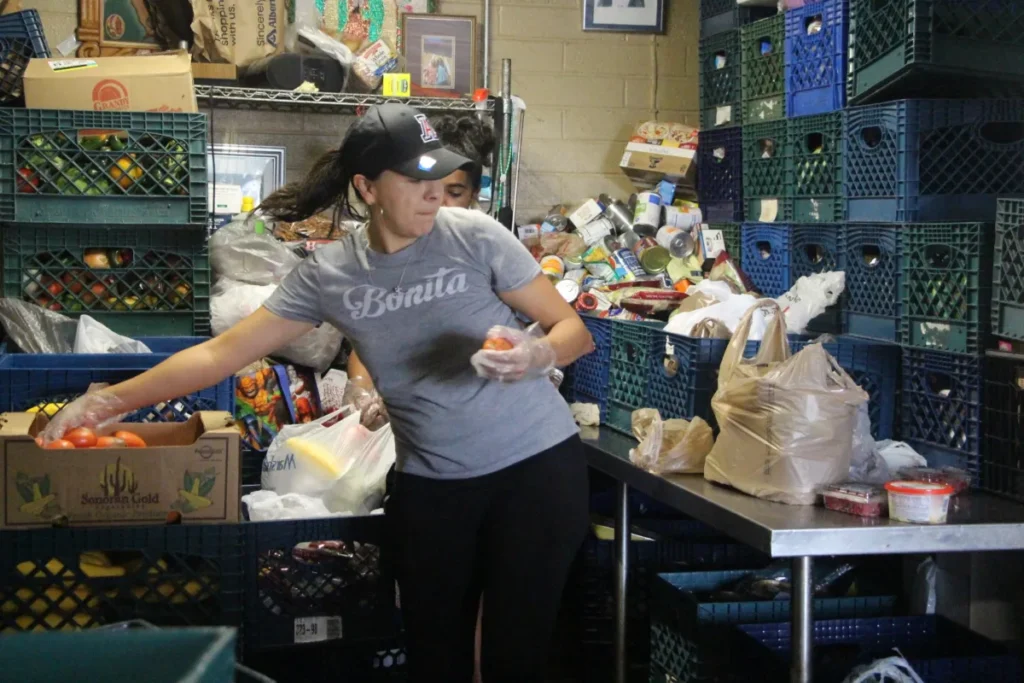
This story was originally published by Arizona Luminaria.
On Tucson’s south side, on the corner of Third Avenue and 25th Street, sits a little shack with a roof of solar panels. At the front, behind its chain link fence, a fading hand-painted picture of La Virgen de Guadalupe greets all who approach. It’s Saturday, and Casa Maria welcomes anyone in need of a meal.
Outside, volunteers form themselves into a human assembly line: a church volunteer with graying hair, a University of Arizona student, and locals from the barrio, some sporting baseball caps, others cowboy hats. They begin to unload box after box of donated food — tomatoes, a battered box of lettuce, apples that didn’t sell — days-old produce that typically goes to the garbage.
People line up outside of Casa Maria, waiting to be fed. Inside, five other volunteers try to keep up with the food that keeps coming in. Lisette Guevara, 45, darts from food crate to food crate, harvesting fruits from one crate, pasta from another, as she rapidly packages well-rounded meals into plastic bags.
“If we weren’t giving away all this food that comes from the grocery stores, they were just basically going to throw it away,” Lisette says, gesturing to all the crates of food stacked around her and all along the walls. Her dark hair is tied into a ponytail, snug under the black cap that helps keep it in place. She breaks a sweat as she hefts 15-pound crates filled with cans and dried goods from one pile and sets them on another with a loud smack.
Along with her 12-year-old daughter, Arianna Anderson, she tries to volunteer at Casa Maria every Saturday.
A lot of the food being donated hasn’t expired. The fruit might have a bruise, a pasta box might have a dent, or some other imperfection that might make the food unfit to be sold at grocery stores.
“A lot of it is edible and still good,” says Lisette, scanning the pounds of nutritious food around her that, until recently, had been destined for the landfill.
A 2022 study found that Arizona wasted more food than any other state in the country, throwing away a whopping $9.5 billion worth of produce and other foodstuffs into the landfill. Worldwide, one-third of all food is thrown in the trash, according to the Food and Agriculture Organization of the United Nations. During the holiday season, food waste typically spikes.
Casa Maria is not only working to combat such profligate food waste, but is also nourishing their community at the same time. More food in the hands of the community not only means fewer hungry mouths, but also prevents landfill methane emissions, a pollutant 28 times more potent than carbon dioxide.
Lina Lopez, a single mother of three, struggles to support her family. Rent is high and she doesn’t qualify for food stamps, she says, but Casa Maria helps her put food on her table. Even though her kids can be picky, she can’t bring herself to toss food out.
“I like to share, too,” Lopez says. Her loose gray hoodie isn’t enough in the cold shade. She adjusts her dark, black sunglasses, and she steps out into the warmth of the winter sun.
This holiday season, anybody can follow Lopez’s lead in bite-sized yet impactful ways. “Most of the food that I don’t eat or my kids, we just share it around Tucson,” Lopez says.

Of all the other meals of the year, people tend to waste the most food during Thanksgiving, according to ReFed, a national nonprofit that dedicates their work to ending food waste. The nonprofit estimated that in 2023, Americans likely wasted an estimated 312 million pounds of food on Thanksgiving, seven million more pounds from last year.
Such excessive food waste has direct effects on the environment. For every wilty head of lettuce, souring carton of milk, or box of going-soft strawberries that get thrown away, the resources that went into producing them — water, soil, fertilizer, and labor — are rendered all for naught as well.
This Thanksgiving, ReFed estimated that the amount of water wasted, from all the food it grew, was enough to fill 156,908 Olympic-sized pools, or 103.6 billion gallons of water. In the U.S., farms are wasting 21% to 33% of all water used to grow their products.
Laurel Bellante, the director of the Food Studies Degree Program and assistant director for the Center for Regional Food Studies at the University of Arizona, described the urgency of developing more responsible relationships with food. “The food system, in general, is one of the leading causes of climate change in the world,” Laurel Bellante said.
Most waste happens at home, experts say. The average U.S. household wastes at least 43% of food, compared to the 40% of waste that comes from restaurants, according to ReFed.
“People can find ways to redirect their food waste so it’s not ending up in the trash heap. It is really important that as an individual, or as a family, you can reduce the ecological footprint of your food choices,” Laurel said.
Food expiration labels — those little dated “Best By” stamps that might scare you into throwing months-old mayonnaise jars into the trash bin — create plenty of confusion.
The fact is, experts say, such expiration dates are misleading.
“The prevailing wisdom of ‘if in doubt, throw it out’ is resulting in tremendous food waste,” according to a report from the Grocery Manufacturing Association, “Best if Clearly Labeled.” The report also cites work done by the Harvard Law School Food Policy Clinic and the Natural Resources Defense Council. They found that more than 90% of Americans may toss out their food too early due to misinterpreting date labels.
So the association wants to make labels less confusing in order to prevent food waste. In general, the phrase “Best if Used By” describes the quality of the product. It might not taste as good as before, but is still safe to eat, according to the Grocery Manufacturing Association, recently rebranded as Consumer Brands Association.
The phrase “Use By,” meanwhile, indicates that perishable products should be thrown away if not eaten before the listed date.
Improved date labeling “is a step toward meaningful food waste reduction that makes it easier for Americans to shop smarter and throw away less,” the president and CEO, Geoff Freeman, of the Grocery Manufacturers Association, shared in their press release “87% of Products Are Now Using Two Date Labels, Creating Needed Clarity.”
While many people in the U.S. continue to fill their trash bins with overlooked food, others still don’t have enough to put on their plates. In 2022, 12% of people in the U.S., or about 44 million people, faced food insecurity, according to the United States Department of Agriculture. Of that total, one in five were children.
In Arizona, one in 10 people, or 752,690, face hunger, 226,080 of those are children. Just in Pima County, about 11% of people are food insecure, according to Feeding America, the largest nationwide nonprofit organization.
Feeding America partners with the U.S. Department of Agriculture on the implementation of federal nutrition programs and helping to contribute to food assistance and meal programs.

Brian Flagg, a long-term volunteer who lives at Casa Maria, wears a soft, brown beanie. On a cold morning in early December, his blue eyes squint up at the pale sun. He zips up his hoodie, rubs the stubble on his face, and reaches for another bag filled with rescued food.
“I live off the food that other people throw away,” Flagg says. Part of the Casa Maria family for almost 40 years, Flagg is a reliable and welcome presence to much of South Tucson’s Barrio Libre. “I’ve lived and worked here since 1983, soy veterano,” he says, laughing.
Casa Maria hands out 400 lunch bags and 80 family bags a day, all made from donated food that would have otherwise been thrown away.
Whether you bought too many boxes of mashed potatoes or too many cans of green beans, if you don’t think you’ll use them, donate them to your local soup kitchens like Casa Maria, Flagg says. If you have cooked leftovers you might not want, Casa Maria will take them, just try to make sure they’re fresh.
Not all soup kitchens will take everything so make sure you check guidelines first. Here is a list of Tucson soup kitchens and food pantries.
An apple in the dump can’t breathe. That’s because, for all but the top layer of trash, food waste is suffocated under tons of other garbage. The decomposition of food waste thus takes place anaerobically, without oxygen. The bacteria gnawing away on that buried apple emit methane, which slowly smokes to the surface and then into the atmosphere.
Methane is a gas that, over a 20-year period, is about 80 times more powerful at warming the planet than carbon dioxide, according to The United Nations Environment Programme.
Food waste accounts for 58% of all landfill emissions, according to the United States Environmental Protection Agency. Which is just another reason why Casa Maria volunteers do everything they can to avoid sending food to the dump.
“If stuff’s really rotten, we put it outside and people take almost all of it and feed it to chickens and pigs and whatnot or they compost it,” Flagg said.
The very last option should be the garbage or landfill.
If your leftovers aren’t fresh enough to be donated, Bellante says it’s best to feed them to your garden. Composting lowers greenhouse gasses through aerobic decomposition, preventing the methane-producing microbes from forming because of the presence of oxygen in the process.
If you don’t have a garden or compost bin, Flagg says you should try giving them to someone who does or get in contact with local community gardens to see if they’ll take your food waste. Here’s a list of Tucson community gardens.

Arianna Anderson separates food so her mom, Lisette, can make them into meal bags. At 12 years old, she credits both school and social media for making her aware of the impact food waste has on the world and on her community.
“You go behind anywhere — Starbucks, McDonald’s, Dunkin’ Donuts — you go into their trash and they have tons of food. Packaged or some are unpackaged, but they are good,” she says.
Arianna’s dark hair bounces in her ponytail as she moves quickly. A can of food in each hand, she straightens up and adds. “You can donate them here. They’ll get fed to people that actually need it.”
For more information about Casa Maria, visit casamariatucson.org. Check out the original article and more at azluminaria.org.
Tucson Foodie is a locally owned and operated community. Thanks to our partners and members, we are able to offer paywall-free guides and articles. We value your support and invite you to become a Tucson Foodie Insider today.
Writer for ArizonaLuminaria.org.